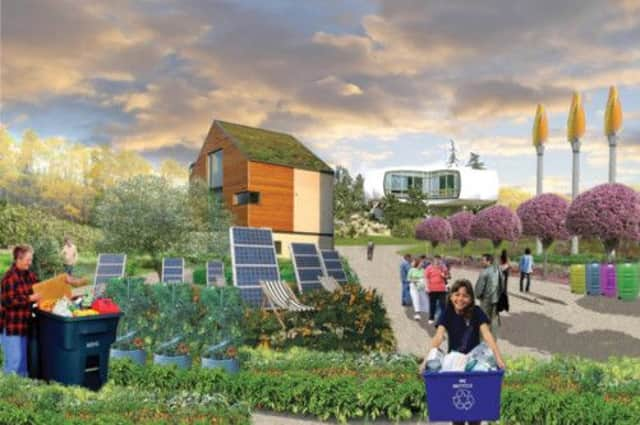Malcolm Fraser: Assault on green belt must be resisted


PREPARE yourselves planners, councillors and the people of Edinburgh in general, for the (David) Murray Estates “Garden District” public relations onslaught is about to turn the volume up to 11.
The first stages of an eventual planning application for a massive total of 3,500 homes, and businesses and parks – with community and sustainability heavily featured in the nice pictures you will soon see regularly in these pages, have been submitted to the council.
Advertisement
Hide AdAdvertisement
Hide AdThe nice pictures are full of allotment sheds, wind turbines and happy children and even, sometimes, houses. Whether the nice pictures or the greater vision is deliverable, is another matter. Visions of butterflies and windmills tend to get sunk by dreary economics and turn out to be Trojan horses for the usual car-dependent suburbs with business and retail parks scattered about.
If Murray Estates delivers what it advertises, it will be the first. But the optimist in me does admit that the happy family environment of the vision is grand. I’d love it to be for one of Edinburgh’s large brownfield sites, already cleared, with local schools, shops and parks desperate for the new life it would bring. It might be Craigmillar, or one of the many areas of dereliction strung from east to west across Edinburgh’s waterfront.
But, of course, it isn’t. For this is a green belt buster – and the onslaught we are about to experience is intended to make us so enamoured of the vision that we don’t notice that it is simply in the wrong place.
Developers find building in our Craigmillars or Waterfronts a bit of a challenge. The costs are greater and the surrounding communities not the sort of address it is easiest to market. Their costs are lower on farmland – but the long-term costs to the public purse much greater, with our taxes carrying the greater infrastructure costs of car growth, bus and bin lorry routes and schools needed, while also carrying the price of social decline in our city sites, closing down schools and financing regeneration initiatives.
In support of its application, Murray Estates points out that the south-east of Scotland “requires” 107,500 new homes in the next 25 years, so we’d be as well to give-up the green belt now.
Its masterplanner, celebrity American “urbanist” Andrés Duany, tells us that we must build on the green belt because “you can’t build family homes in the city”.
The first argument is desperately-flawed, the figure plucked out the air and needing an enormous new property bubble to fund it. There may be a theoretical “need” for 107,500 new homes but I will be very surprised if there is the ready finance of the Gordon Brown Boom, to sustain their mortgages. Without such finance we are going to have to find new ways of living together, with generations sharing, and more intensive use of our town and city centres. And if I’m wrong: well the answer is still to build on our brownfield sites first, and get to the green belt if and when it’s needed in, say, 2025.
The second argument – that family homes cannot be built in the city – is deeply disturbing and divisive, representing an American attitude that sees the city cleansed of the lifeblood of families, fit only for Sex and the City sophisticates, or a poor or immigrant urban underclass. But we are Scottish and, I believe, most of us still share a view of our towns and cities as places for the whole community, where all ages mix.
Advertisement
Hide AdAdvertisement
Hide AdSadly, that’s a vision that our house-building industry doesn’t deliver. It has succumbed to the same contemporary American city-suburb division, building towering dockside flats with stuck-on balconies for beautiful young bankers to sook G&Ts on, or suburban boxes with teeny wee gardens for when they get kids.
They haven’t noticed that families, too, like to live in the city – walk to work or school, play in its parks and visit the wealth of the town. They haven’t imagined that there may be models that deliver both the density the town requires and the amenity – the gardens and sunny community spaces – that a modern family might seek.
To its great credit, the city council is leading the way here, its 21st Century Homes initiative asking for answers to those questions. My practice is building, at Leith Fort, for the council and the Port of Leith Housing Association, a contemporary version of the classic Victorian colonies – a ground floor flat with a maisonette above, each with its own garden and with a wee village green at its heart. The colonies were originally constructed by workers’ Co-ops and remain a great model for family living – as dense as tenements but with a garden for everybody, an exemplar of what family homes in the city could be.
We need our house-building industry to follow such leads. And we need our entrepreneurs to not commit their great resources into persuading our local authorities to rip up the policies that protect our dense, walkable, liveable places. Would that David Murray turn his money, initiatives and the undoubted talents of his huge team to our languishing but full-of-potential brownfield sites. Until then, the city should hold its nerve, apply the polices it has so painstakingly drawn up to protect the city, and send the “garden district” packing.
• Malcolm Fraser is head of Malcolm Fraser Architects